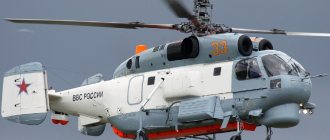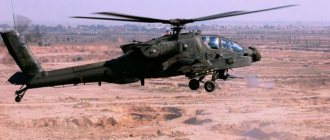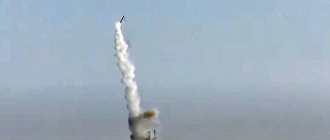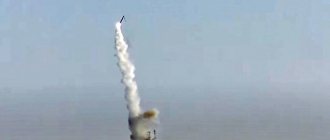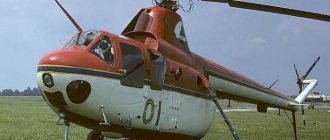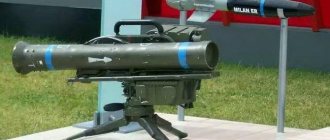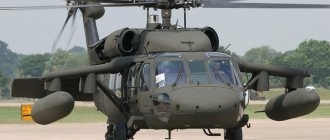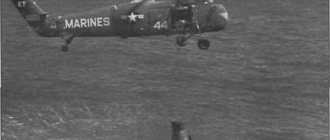“Product 503” was the name of the future Ka-31 helicopter. It was intended for radar patrol and was used in the USSR Navy. The model was developed on the basis of the transport-type Ka-29 naval combat helicopter and was used for long-range radar reconnaissance. The device is unique in that it is capable of being based both on land and on a ship of any class (naturally, those designed to receive aircraft). The Ka-31 was often used in ground conditions to solve air defense problems. Until now it has no analogues.
The Ka-31 is in service with naval aviation in three countries: Russia, China and India. As of 2012, the Russian Air Force owned two copies, nine helicopters were exported to the Chinese Air Force, and 14 models were in India.
The main activity of the Ka-31 AWACS is radar control of sea and air space, early detection of low-flying targets such as a helicopter, cruise missile or airplane. Among other things, the helicopter is capable of detecting and recognizing surface ships at long range. The Ka-31 has electronics capable of calculating the trajectory and parameters of a target’s movement, and coordinates. Can transmit necessary information to the command post and to the based ship.
The machine is created on the basis of a screw coaxial design. The designs of the carrier and main systems were borrowed from the transport and combat Ka-29. Some changes in the design were made due to the need to install a radar on the bottom. Thanks to a special hinge system, the radar can be rotated in different directions and take a vertical position. The radar antenna mirror has a span of six meters. During normal transportation, the antenna is pressed against the body (to the bottom) and fixed.
The door was installed on the right side of the transport cabin. For the crew, emergency hatches with glazed doors are installed on the sides. In case of an emergency they have an emergency release capability. The landing gear is four-legged, the front ones can be retracted into special fairings (located on the outside on the sides of the fuselage). And the main supports rise up, thereby freeing up space for the radar antenna to rotate in flight. The main rotor blades are made of polymer and composite material. They are also supplied with electro-thermal and anti-icing systems.
History of the Ka-31
The need for any country with sea cordons for AWACS became clear during the military conflict between England and Argentina over the disputed Falkland Islands. The Argentine Air Force had the advantage of low-flying aircraft, which sank two British ships: Coventry and Sheffield. The British could not intercept the planes because they did not have AWACS radars.
It was for these reasons that the N. Kamov Design Bureau received the task in 1985 to create an AWACS helicopter. It was based on a glider, power and load-bearing systems from the Ka-29 helicopter. The only difficulty was finding a way to install a radar on the helicopter. Various problems arose: unstable flight and constant shaking when the radar rotated, a conflict between the radar systems and other navigation equipment. The first OP took off in 1987, and the helicopter entered the ranks of the Russian Navy only in 1995. Serial production for naval aviation was carried out at the Kumertau plant.
Design
The device is based on a screw pattern of rotation axes. Each propeller consists of three blades. The propellers rotate in different directions and have the ability to fold when parked. The blades are made of composite, polymer material. Protection against icing at high altitudes is provided by a special icing system.
The helicopter is equipped with a radio technical complex, consisting of a target identification device based on nationality and a radar station. The latter works in tandem with a phased array antenna, which is attached to the bottom of the helicopter fuselage. In working condition, it unfolds 90 degrees and moves in a circular motion, while occupying an area of 6 sq.m. The antenna length is 5.75 m, the weight together with the station is about 200 kg. When a target is detected, information is instantly processed and automatically transmitted to the command post.
Read Ka-60 Kasatka Helicopter
Features of the Ka-31 aircraft
The Navy used the helicopter to detect surface ships and air targets and escort them if necessary. Those units that were based directly on ships were used as air defense support for combat formations of the entire fleet. The powerful radar is mounted on solid-state elements and, when turning during flight, can release the antenna along with the phased array (phased array antenna).
Thanks to the onboard radio-electronic complex installed on the helicopter, the Ka-31 can fly automatically along a programmed route, regardless of weather and climatic conditions. The AWACS helicopter is capable of simultaneously detecting and tracking up to twenty objects.
The automated mode facilitates fast and, most importantly, automatic transmission of information about found targets to the control center. Transmission is carried out using a telecode channel. The “Oko” or E-801 system, created at the Research Institute of Radio Engineering (Nizhny Novgorod region), allows you to detect any surface or low-level object at long-range radar frequencies.
The antenna is specially attached to the bottom of the Ka-31 to reduce aerodynamic drag and prevent it from deteriorating during landing. In operation, the antenna tilts 90 degrees and the landing gear rises. The headlamps together with the radar weigh about 200 kg, the antenna rotation area is six square meters, and the length reaches 5.75 meters. A surface object is detected at a distance of more than 250 kilometers, and an air object is detected at a distance of up to 150 km.
Especially for helicopters of the detecting and reconnaissance classes, the Instrument Design Bureau (Saratov) developed a flight navigation complex (FNC). The general operating mode of the radar and PNK is simple. When the radar is operating, the PN complex establishes stabilization of the angular position, is responsible for the barometric or true flight altitude, determines the flight in the sentinel zone of a typical trajectory, automatically brings the vehicle to a ship or airfield, and also makes it possible to bring the helicopter to the landing point using radar landing signals .
The transmission of the received information via closed and open channels is carried out by a special communication complex installed on the Ka-31 AWACS. Transmission is carried out by telecode channel. The helicopter can transmit information at a distance of 150 km from its home base, and at the same time the altitude can reach 1500-3000 meters. Flight parameters are recorded automatically using specialized recording equipment “Tester-3K”.
In addition to naval use, the helicopter can also be used for ground forces. The Ka-31 is capable of being deployed at small unprepared sites that are located near mobile anti-aircraft missile launchers. AWACS provides pointers to the target.
But mass production ended before it really began. The Russian Navy began the complete elimination of ships designed under number 1143, which led to a loss of interest in the Ka-31 helicopter. Only two copies are in use. They are located at the Admiral Kuznetsov aircraft carrier base. They wanted to increase the number of Ka-31s in connection with the purchase of special Mistral helicopter carrier docks from France, but due to the imposed European sanctions this will not happen. The scandal occurred due to Russia's support for separatists in Ukraine.
Description
One of these models was the KA-31 helicopter, unique in its characteristics, developed at the Kamov design bureau of the Ukhtomsk Helicopter Plant, currently part of the Russian Helicopters holding company. The device is designed to conduct radar reconnaissance operations behind enemy ships, low-flying aircraft, helicopters, and cruise missiles. KA-31 uses as a base the platform of any ship, equipped to receive helicopters. In addition, it can be used as an air defense weapon, performing tasks of detecting targets and transmitting data to accompanying anti-aircraft missile systems. The Ka-31 helicopter is capable of keeping watch over enemy targets around the clock, at any time of the year and regardless of weather conditions.
The helicopter is intended for deployment on Russian Navy vessels such as the heavy aircraft-carrying cruiser Admiral Kuznetsov. Currently, a small number of KA-31s are in service with our fleet. This is due to the low-intensity use of vessels of this type. However, the Russian Defense Ministry does not lose interest in this type of aircraft and plans to prepare new ships for them. In particular, Mistrals were ordered from France for the KA-31, but for known reasons the deal did not take place. The helicopter is actively used in the foreign navies of India and China. Other countries are also showing interest in it.
Read Mi-35 helicopter - export version of attack helicopter
Construction[ | ]
The main element of the design is a radar with a rotating antenna 5.75 m long and 6 m2 in area. The antenna is installed under the fuselage and is adjacent to its lower part in the folded position. During operation, the antenna opens 90° downwards, while the landing gear supports are pressed against the fuselage so as not to interfere with the rotation of the antenna. The antenna complete rotation time is 10 seconds. The radar provides simultaneous detection and tracking of up to 20 targets. The detection range is: for aircraft 100-150 km, for surface ships 250-285 km. The patrol duration is 2.5 hours when flying at an altitude of 3500 m.
To stabilize flight with a rotating antenna, a special flight and navigation complex was developed. It also functions as an autopilot, providing automatic landing and hovering at an altitude of 25 m above the landing site. The Ka-31 helicopter can fly at any time of the day and in difficult weather conditions.
In service[ | ]
Is in service[ | ]
Ka-31 of the Indian Navy
- Aviation of the Russian Navy - 2 Ka-31R, as of 2016[3][4].
- Indian Navy Aviation - 14 Ka-31, as of 2022.[5][6] In August 1999, India ordered 9 Ka-31s for a total of $207 million. The contract was completed by the end of 2004. In 2009, 5 more Ka-31s were ordered at a cost of about $20 million each[7].
- Naval aviation of the People's Republic of China - 9 Ka-31, as of 2016[8][9][10].
Was in service[ | ]
- Aviation of the USSR Navy
Links[edit]
- ↑
Paul Jackson (1999),
Jane's Planes Around the World, 1999–2000
, p. 372 - "Archival copy". Archived from the original on 2002-01-06. Retrieved 22 August 2008.CS1 maint: archived copy as title (link)
- https://www.airforce-technology.com/projects/ka31/ [ unreliable source?
] - http: //www.m military-today.com/helicopters/kamov_ka31.htm Archived July 31, 2022 at the Wayback Machine KamovKa-31 Helix data military-today
- "Archival copy". Archived from the original on 2008-09-17. Retrieved 22 August 2008.CS1 maint: archived copy as title (link)
- "Ka-31 in the Chinese PLA Navy". Archived from the original on May 20, 2013. Retrieved June 12, 2013.
- ^ ab "WORLD AIR FORCE 2011/12" (PDF). Flightglobal Insight. 2013. Archived May 9, 2013 (PDF). Retrieved March 1, 2013.
- “World Air Forces 2000 Pg. 85". flightglobal.com. Archived from the original on July 3, 2015. Retrieved March 1, 2013.
- Gordon, Efim; Komissarov, Dmitry (2005). Soviet/Russian AWACS aircraft: Tu-126, A-50, An-71 and Ka-31
. Hinckley: Midland. ISBN 9781857802153. - ↑
Armistead, Edwin (17 March 2002).
AWACS and Hawkeyes: The Complete History of Airborne Early Warning Aircraft
(1st ed.). MBI Pub. Co / Zenit press. paragraph 126. ISBN 0760311404.
Notes[ | ]
- Kamov KA-31 (unspecified)
. www.airwar.ru. Date accessed: June 24, 2022. - A new Russian air reconnaissance aircraft is undergoing combat testing in Latakia // Oct 2016
- Order of Battle - Russia (unspecified)
(inaccessible link). Retrieved September 1, 2012. Archived August 20, 2022. - The Military Balance 2016, p.193
- Order of Battle - India (unspecified)
(inaccessible link). Access date: September 1, 2012. Archived September 30, 2013. - The Military Balance 2016, p.253
- India approved the purchase of Russian Ka-31 helicopters
- Order of Battle - China (unspecified)
(inaccessible link). Access date: September 1, 2012. Archived December 24, 2008. - It is possible to continue cooperation with China on deck helicopters
- The Military Balance 2016, p.244
Specifications
- Length – 11.6 m (without propeller).
- Width – 3.8 m.
- Height – 5.6 m (along the screw sleeve).
- The diameter of the main (main) rotor is 15.9 m.
- Type of motors and power - 2 gas turbine engines Klimov TV3-117VK, 2 x 1660.
- Maximum and cruising speeds are 255 and 220 km/h.
- The achievable and average altitude ceiling is 5500 and 3500 km.
- Flight range – 680 km.
- The cost of the helicopter is more than 4.5 million rubles.
- The Ka-31 has a modification with the index P, installed on it with the BKS-252 complex.
Characteristics of location systems
- Detection of surface targets is carried out at a distance of 250-285 km, aviation - 100-150 km.
- The transmission of information about the target is transmitted at a distance of 150 km at an altitude of 1500-3000 km.
- The period of one scan is 10 seconds.
- The maximum number of tracked targets is 20.
- The operating viewing range is 360°.
All equipment of the complex is highly automated. The detection system independently sets all parameters of the target: coordinates, speed, course, affiliation with any state and transmits a message to the command post and interceptor aircraft. The navigator sees only the number of its designation on the monitor screen and controls the actions of the system. The crew of the car consists of three people.
